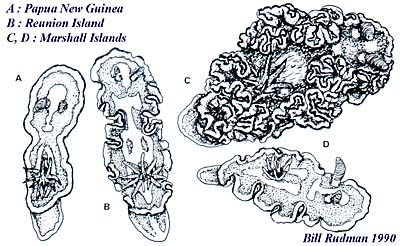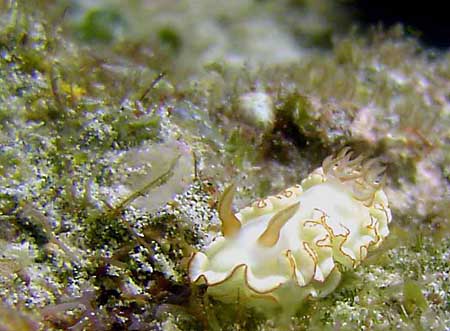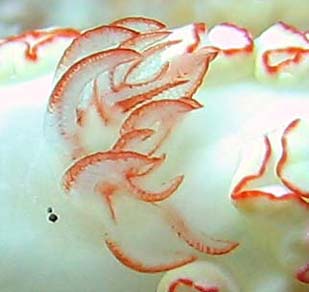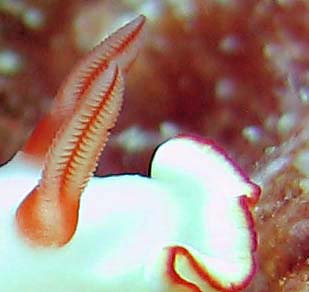This species has been observed on Reunion, Mayotte and Madagascar Islands
Species characteristics : Relatively wide mantle skirt which has one major fold midway down each side and can have many secondary folds as well |

|
|
| Showing species characteristics... | Photo Maurice Jay Holotype. Reunion, St.Gilles Reef, Reunion Island. January 1974, size : 19 mm |
|
Remarks :
Identification confirmed by Bill Rudman
Gosliner & All in "Nudibranch and Sea Slugs identification, Gosliner, Valdès and Behrens, 2015" consider that there are two very similar species Ardeadoris symmetrica (from Indo Pacifique) and Glossodoris sp. 9 (from Madagascar). In the absence of publication I chose to keep the term of Ardeadoris symmetrica for this species ...
In many specimens of this seaslug from Reunion and Mayotte Island we observe a thin orange-red border on the foot, like around the mantle. This pattern variation wasn't describe in Rudman publication (1990)
This seaslug mimics the flatworm Pseudobiceros sp1, a flatworm which is commonly found in South Africa, Madagascar and Mayotte
This species looks like Ardeadoris cf. symmetrica but in Ardeadoris cf. symmetrica there is no opaque white marking looks like a little man on the notum
Synonymous : (according Worms)
- Glossodoris symmetrica, Rudman, 1990
Bibliographic data :
This upper photo corresponds to a specimen collected by M.Jay in St Gilles Reef, Reunion Island, Indian Ocean, January 1974, which served of holotype for Bill Rudman when he described this species in 1990.
The name A. symmetrica is a reference to the symmetrical white patch or patches down the midline of the mantle.
Some large specimen has a much more folded mantle skirt, the secondary folds being as large as the major midway fold on each side
The mantle is translucent white with a broad opaque white band around the edge and another down the midline, starting in front of the rhinophores and running back behind the gills. This median band is somewhat irregular in width but forms a pattern symmetrical around the midline and sometimes broken into an anterior and a posterior section. This characteristic opaque white patch on the dorsum develops with age.
The foot and sides of the body are also a translucent white with a broad opaque white border and a white band down the midline of the posterior foot visible behind the mantle.
The gills of this seaslug are arranged in an arc around the anal papilla. The arms of the arc spiral inwards to form a secondary coil on each side. The gills, simple in smaller specimens but quadrangular in section in the largest specimen, vibrate rhythmically. They are translucent white and edged with orange-red. Towards the tip of each gill the gill lamellae are also edged in the same colour.
The rhinophore stalks are translucent clear with a heavy red dusting and the club which is also translucent clear and tinged with orange-red, has a vertical red band up both the anterior and posterior midline.
This species has a symmetrical opaque white marking on the mantle, similar to that found on G. pallida .
It differs from G. pallida :
- In having an orange-red mantle border (yellow in G. pallida ), similar colour differences on the rhinophores and gills.
- Absence of orange-red foot border (yellow foot border in G. pallida ) Some specimen in our island have an orange-red foot border
- The form of the opaque white marking looks like a little man in A. symmetrica (see below : Florence Trentin's photo) and a heart-shape pattern in G.pallida.
References :
Bill Rudman Seaslug site : Sea Slug Forum : Glossodoris symmetricus
Nudipixel Glossodoris symmetrica
Publications :
Johnson R.F. & Gosliner T.M. (2012) Traditional taxonomic groupings mask evolutionary history: A molecular phylogeny and new classification of the chromodorid nudibranchs. PLoS ONE 7(4): e33479.
Rudman, W.B. (1990) The Chromodorididae of the Indo-West Pacific: further species of Glossodoris, Thorunna and the Chromodoris aureomarginata colour group. Zoological Journal of the Linnean Society, 100(3) : 263-326.
Other photos of Ardeadoris symmetrica :
| Florence Trentin Reunion, "Les kiosques", at Saint Leu, 15 m, size : 30 mm, 4 November 2006 |
In this specimen, we observe a thin orange-red border on the foot, like around the mantle. This variation wasn't describe in Rudman publication (1990) The gills are arranged in an arc around the anal papilla. The arms of the arc spiral inwards to form a secondary coil on each side.  |
 |
Florence Trentin Reunion, St-Leu, crawling on the substratum during the daylight hours. The form of the opaque white marking looks like a little man in G.symmetricus and a white band down the midline of the posterior foot visible behind the mantle.
|
 |
 |
Emmanuel Eby Reunion, Saint Leu, 10 October 2004 In this specimen, we observe a thin orange-red border on the foot, like around the mantle. This variation wasn't describe in Rudman publication (1990) |
Delphine Dupin The gills are translucent white and edged with orange-red. The rhinophore stalks are translucent clear with a heavy red dusting and the club which is also translucent clear and tinged with orange-red, has a vertical red band up both the anterior and posterior midline. |  |
 |
 |
Sebastien Flouvat Reunion, Cap La Haussaye, 8 m, 13 October 2007 Always a thin orange-red border on the foot, like around the mantle. |
Maurice Jay Reunion,
|  |
More photos from Indian Ocean
Mayotte, Ardeadoris symmetricus with an orange border on the foot, at Hajangua, by Matthias Deuss
Reunion, lateral view of Ardeadoris symmetricus, at Saint Gilles, by Sophie Darnis
Madagascar, Ardeadoris symmetricus, at Nosy Bé, by Alain-Benoît Rassat
